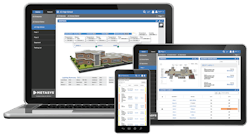Building Management, Building Automation and Digital Transformation
Chris Lane is the Director of Product Management for Building Automation System (BAS) products at Johnson Controls. In this role, Lane leads a team of product managers responsible for defining the strategy and direction for Johnson Controls’ global portfolio of BAS products. Lane began his career with Johnson Controls over 30 years ago and has a Bachelor of Science degree in Electrical Engineering from University of Wisconsin - Platteville and a Master’s degree in Business Administration from Cardinal Stritch University.
Lane spoke with CONTRACTOR about the benefits of digital transformation in the built environment for building owners, managers and occupants.
CONTRACTOR: Can you give us a good definition of digital transformation in the context of building automation?
CONTRACTOR: How do you start the conversation with clients who are new to digital transformation?
Chris Lane: Usually when we kick off those kinds of conversations, we talk about their strategy, and sometimes that’s a difficult question. You’ll get varied responses, ranging from, “we have very defined sustainability goals,” or “we have certain year-over-year energy reduction targets.” But sometimes their goals are somewhat fuzzy. Sometimes they aren’t smart, or actionable—they may not be well-known throughout the entire organization. So, the customers we might be dealing with might not be “in the know” as far as the broader organizational, corporate strategy goals.
So, the first thing, we try to work on with them is to understand what their plan is. What are you trying to do here? Do you have sustainability goals? Can you share that with us? Do you have a year-over-year energy reduction goal? Can you share that with us? And maybe they don’t have those goals yet. Maybe it’s ill-defined, but something they know they should be doing. Like, they would like to be able to reduce the number of hot- and cold-call complaints from their occupants. Maybe they want to make sure they can onboard a staff member very quickly, get them up to speed and able to deliver some of the facility outcomes that they’re looking for. Keeping their equipment maintained more effectively.
Understanding those goals, and then, what—from a digital technology perspective—is possible. We start brainstorming some ways to solve the problems they have, with achieving those goals. And try to create that kind of alignment between the appropriate technology and the goals they are trying to reach or the problems they are trying to solve.
It's usually never “Hey, we have a solution that’s going to do this for you.” There are so many building types, there are so many kinds of building owners, so many value chain providers, and they all have their own unique perspectives, unique expectations. It’s trying to understand what those are and then choosing the right digital technology, the right digital transformation initiative that will align with those goals.
When you start talking about this kind of digital transformation, you want to make sure they have an expectation they are going to gain commitment from their organization, from their staff. A lot of times digital transformation can be a frustrating experience to people who are new to these technologies, or who are set in their ways, or who have had more experience doing things their way in the past.
CONTRACTOR: It can be scary, adopting new systems, new technologies. Do some clients need reassurance as they move towards transformation?
Chris Lane: First, we reassure them that they’re not going to be the first. They’re probably lagging some of the contractors doing similar work. That unless they get on the digital transformation bandwagon, they may find themselves dragging their own growth plans. Then we show them some use cases of where digital transformation can provide an outcome that may have been a surprise over legacy thinking, or solving a use case that may have been unknown until a digital solution had been provided. Show the results, the effectiveness, using use case examples… showing result that are above and beyond what they were able to deliver before.
Depending on their level of adoption of digital technologies, it will depend, but if you start talking to them about real-life consumer application of digital transformation, for example, everyone is likely using a smartphone and is chatting, and is providing predictive text options—that’s digital transformation, that’s artificial intelligence, working behind the scenes to make you a better communicator.
So there’s that reassurance, that guidance. Making sure that they have an inventory of their current assets. A lot of the building automation systems that are installed in buildings today are already using some type of network, some type of digital asset. Do they know what those are? Do they know what revs they’re at? Do they have an as-built of all their BAS components, all the equipment controllers, all the supervisory controllers, the software that’s being used, and then what version that they’re at? Some building automation system providers, including Johnson Controls, may have tools to help them create that inventory.
So, they understand what they have, and then start looking at what are the oldest areas and how do you get them upgraded, what are the areas that could be upgraded with minimal disruption. Identifying, what would it take if I wanted to change this equipment controller from communicating via an older, legacy, proprietary slow protocol, to one using, maybe, IP-based ethernet networking protocols. What would that take? Is that a rip-out and replace or is there a gateway you want to add. Start walking through their system and finding areas of improvement that could a) add value and b) not be so disruptive to their operations.
CONTRACTOR: I understand there’s a kind of “snowball effect” once all these digital systems begin interacting with one another; as more data gets shared, more efficiencies come to light.
Chris Lane: Traditional building automation systems do have components that talk to one another, but often they’re leveraging slower speed networks or maybe a proprietary protocol. In the age of digital transformation, now we’re talking more about IT-friendly networking technologies, like IP or ethernet based hardwired networks, or maybe wireless wi-fi networks, and now more open protocols, whether they be building automation protocols like BACnet or more IT-friendly data exchange mechanisms like using restful APIs.
Restful APIs are ways to exchange data between applications and enable the sharing of large amounts of data. Once you start having that next generation, digitally transformed networking infrastructure, that opens an ecosystem of all sorts of other third-party application providers that can now access your system—with security—using restful APIs or some other mechanism, to allow them to add value on top of your already installed system.
So your installed system may already be adding value, but if you wanted to take it to the next level you now have an infrastructure that unlocks opportunities to partner with all sorts of digital applications like PowerPI or Tableau, or other large-scale data-analytics tools or solution providers themselves, so companies can come in and help you and provide services using the data from your system. All that becomes possible once you begin leveraging some of these new digital technologies.
CONTRACTOR: What’s next on the digital horizon? Right now everyone is talking about AI.
Chris Lane: We talked earlier about Artificial Intelligence and Machine Learning. I would say that those will continue to evolve and get better and find their ways into solving building automation problems more frequently, and more specifically in certain building automation use cases. Oftentimes we may be able to apply some of those solutions without having a reliance on a large-cloud solution provider. Some of the technologies that we are working on involve applying AI and machine learning techniques in the on-premise components, so that if you either did not have a cloud hosted solution, or you had maybe lost connection to the cloud, your analytics—like your fault prediction analytics, or your optimization strategy—could be executed in an on premise component and be delivered with some resiliency there.
I think networks themselves will get stronger. We will start to see more buildings take advantage, more and more, of leveraging IP based networking technologies in their infrastructure. Kind of a bridging of the IT world with our world, the operational technology worlds. We are all leveraging the same types of high-speed, high-throughput, high-bandwidth networking infrastructures, whether that be wired ethernet, or maybe even wi-fi or 5G networks, or other wireless networks. So, the networking infrastructures withing buildings will grow to support the large-scale data needs that digital transformation requires.
I think that the way that humans will interact with their building information systems will be more natural, maybe leveraging some of the natural language processing capabilities that are currently being used by ChatGPT.
I would say a lot of the recent buzz in the normal technology industry has been around ChatGPT. Maybe not that specific application. But how we interface today between the building automation system and humans, I think is ripe for a dramatic change by applying more digital technologies. If you think of the traditional user interface that most building automation systems present today, it’s usually a web browser or mobile app on your phone that shows a graphical image of the building and the equipment inside the building, and usually dashboards that show you representations of certain things like a historical view or a trend view or a scheduling view. All of that is intended to server information up to a human, and the human consumes that information and then it is up to the human to make the appropriate decisions and then take action.
I think all of that is ripe for change. I think that the way that humans will interact with their building information systems will be more natural, maybe leveraging some of the natural language processing capabilities that are currently being used by ChatGPT. I think that building automation systems will become more autonomous, and less reliant on manual intervention. So, instead of raising an alarm and requiring a manual intervention to look at that alarm, or being guided through what would have caused that alarm, instead having the system itself diagnose what could be some of the potential problems and serving up the solutions to the user. Automating those troubleshooting steps, rather than just providing information that is then reliant upon human interaction.
I think that building automation systems will get a lot smarter in that fashion. And it will require less reliance on manual intervention. You’ll see the kind of screens that are typically available today become less “noisy.” I think the ideal screen is, maybe, just one little bar that says, “tell me what’s wrong in room 101—and go ahead and fix it.” And then the system will automatically do that for you. Or at least propose some possible actions that could be taken and then have the operator choose which one they’re most comfortable with.
Those are some of the pie-in-the-sky, long-term, visionary aspects, but certainly something within the realm of possibilities given everything we’ve seen coming out with various consumer-based technologies.
CONTRACTOR: It sound like digital transformation can directly impact the three key concerns of most building managers: profitability, efficiency, and occupant comfort.
Chris Lane: You can use these kinds of technologies to reduce your energy spend, to reduce your carbon footprint. You can optimize your equipment so that any type of breakdown can be prevented. (Preventative maintenance is often much less expensive than going through a costly emergency breakdown.) And a well ventilated, healthy, comfortable, well-lit, safe environment for the occupants leads to better productivity—if you have a building that’s being used by employees that are doing some high-value add within the business.
Or, if it’s just a regular commercially owned building that has tenants, they want to make sure that those tenants are happy, that they’re satisfied, that they’re not looking to leave and find a better place to lease or rent. If you’re in a healthcare situation you want to make sure that your patients are satisfied with the care they’re being given. That also includes their health, their comfort. All that is often surveyed, to make sure that patients have received what they felt was appropriate care, that the environment was good, a lot of health care providers are tracking that.
All that leads to more profitability. We talked about sustainability and meeting sustainability goals, reducing their carbon footprint by reducing their energy usage. All of that is possible through these various solutions and digital transformation techniques.
Johnson Controls is there to be on the journey with our customers. Digital transformation is a tool. It’s not an end-all-be-all, it’s not THE solution, it’s a tool to achieve that solution.
About the Author
Steve Spaulding
Editor-in-Chief - CONTRACTOR
Steve Spaulding is Editor-in-Chief for CONTRACTOR Magazine. He has been with the magazine since 1996, and has contributed to Radiant Living, NATE Magazine, and other Endeavor Media properties.


